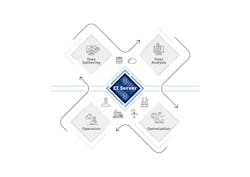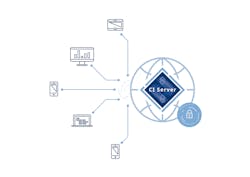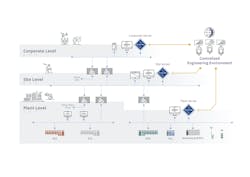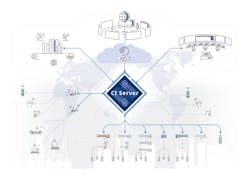Supporting company-wide communication with a collaborative information server
Process manufacturers with complex facilities scattered across multiple sites often learn two truths about helping people work together:
- Remoteness is not a function of distance — two process units can be at a single site and still have no interconnection and no interaction whatsoever.
- Collaboration, when done effectively using digital tools, does not depend on proximity, it can span any distance.
Provided people are willing to engage, what are the best available digital tools, and how do they make a difference? The answer is often a collaborative information (CI) server designed to support integration of the various facilities, systems and equipment across geographically dispersed manufacturing sites (Figure 1), making it easy to share data and information.
A CI server takes advantage of the latest IT equipment and practices to extend process control capabilities, while improving operational and production efficiency. The overarching concept at work is to use digital transformation so a company can move from individual improvement efforts to overall company-wide optimization. Clearly, this is a lot to consider, so we will unpack the concepts and put them in more practical terms.
Emergence of data
When a process manufacturing company (chemicals, refining, etc.) grows to sufficient size, it usually has complex integrated plants spread across multiple sites within the same country, or even globally. Each of these sites typically consist of multiple production units, possibly creating a mix of intermediate and finished products, sending them from one unit to the next.
The units were probably not built all at once to a single master plan. Instead, individual units were likely planned and brought online at different times, or acquired as operating plants, reflecting varying engineering practices and technologies. Some are likely modern, while others are dependent on legacy automation systems. Management and operation of each must reflect its capabilities and condition, which means optimization efforts, when they happen, are all too often one-off, individualized projects.
But this picture is changing. Driven by the need for increased profitability, plants are required to be more flexible and respond more quickly to changes. Companies must monitor and manage integrated operations smoothly and efficiently across multiple units and sites, rather than just executing one-off efforts. This change is supported by digitization of the plants, creating and capturing enormous amounts of data, but this data has to be organized using a central system to make it meaningful and accessible.
A typical plant or production unit produces two main types of data, each appearing in its relevant stream:
- Process data from distributed control systems (DCSs), programmable logic controllers (PLCs) and safety instrumented systems (SISs), all showing real-time process variables, valve settings, outputs, etc.
- Operational data, indicating feedstock and finished product inventories, energy consumption, personnel information, etc. This type of data from the business side of plant operations is typically more associated with IT systems.
Digitization doesn’t create new data as the information has always been there, but instead automates its collection. This relieves the task of manual collection, while delivering greater depth and detail. The objective of this effort is getting the right information to the right people in real time to support effective decision making. This provides quick response to market changes, cost optimization, quality improvement and better operational efficiency.
Some sophisticated companies have one more tool to improve production, digital twins of production units. A digital twin (Figure 2) is a process simulator able to respond to process changes in the same way as an actual plant, allowing various optimization strategies to be tested before implementation.
Digital twins support effective decision making, and the training of operators and other plant personnel.
CI server functions
The discussion so far probably sounds clear enough, but actual implementation is more of a challenge. For many companies, the required networks and tools all exist, at least to a certain extent, but they are likely local and isolated by site, or even by unit. This brings us back to the idea that remoteness is not a function of distance because it can even apply if two units are side-by-side.
Getting the most from data analysis and even process control requires centralization so engineers and managers at headquarters can view any data from any location and process unit as needed, and then take appropriate action. Providing this ability is the primary function of a CI server.
A CI server is a cross-platform control and information system that integrates all aspects of operations, process control, data collection, data analysis and artificial intelligence (AI) in a central location. This requires implementation of the latest technologies, combined with deep experience in process control and plant technology. A company wanting to improve its ability to respond to everything from large-scale industry changes to variations in individual processes must keep the big picture in mind.
For example, in order to improve operational efficiency and productivity across all sites and units, it is essential to have consistent collaboration among the operators stationed at each site, as well as with headquarters personnel and specialists in the field.
A CI server links all sites (Figure 3), whether nearby or remote, with all the relevant people in any location. It provides a real-time grasp and overview of production, people, output, inventory and activity at any production site — contributing to improved efficiency, productivity and stable operations at all sites and units.
A CI server supports a variety of external communication drivers and provides an industry-standard open interface, enabling the collection of all process and operational data, plus interaction with digital twins where available. This contributes to overall production optimization efforts by utilizing data collected over long time periods and linking it with applications for process analysis and diagnosis, as well as with information and quality improvement systems.
Support for collaborative operations
The problem with an isolated site or production unit is its inability to draw on resources outside of its immediate reach. Improvements of any kind will be limited to the skills and imagination of those on site, or perhaps local consultants. The degree of skill and specialization will therefore be uneven, leading to disparities across a company’s facilities.
To spread out resources more uniformly, a CI server facilitates plant operations through:
- Local and geographically distributed plant control from a central location.
- Safe and secure data consolidation and distribution.
- Centralized AI capabilities with access to the large pools of data needed to provide sophisticated analysis.
This results in improved decision making at all levels, from an individual process unit control room operator to production and executive management.
As a case in point, when remote operation is a routine availability, specialists such as mechanical and electrical engineers, technical staff for information systems and experts in plant processes who are at headquarters or other sites can serve the entire company, rather than being tied to a specific site. From a central location, they gain a panoramic view of the entire company’s operations and can see where their skills will be most effective.
It is also necessary to remotely monitor the operations at each site in order to solve problems made worse by the increasing scarcity of experienced operators, and the corresponding problem of retaining skills and organizational knowledge. A CI server can connect people wherever they may be, enabling the provision of remote assistance. This improves productivity for the entire company, while ensuring stable and efficient operations, even at remote sites.
Remote control room
As a cross-platform control and information system using the latest technology, a CI server, in addition to being a data-gathering platform, is also an HMI (human machine interface), so it duplicates what operators see in the individual control rooms. The HMI functions using HTML5, allowing it to monitor and execute authorized operations from a remote location (Figure 4) via any device capable of hosting a web browser — such as a desktop or laptop PC, an operator station, a tablet or a smartphone — making it suitable for remote operations.
For example, experts and production managers stationed at headquarters can review the process data seen by the operators at a central production monitoring facility, allowing them to support operators in local control rooms (Figure 5).
Centralized monitoring is especially useful when specialized skills and knowledge are required for on-site work, allowing it to be carried out smoothly via the web without having to dispatch personnel from headquarters, saving time and travel costs. A CI server’s web browser environment can also be secured to protect against unauthorized access, data theft, leaks and other cyber threats (Figure 6).
In addition to supporting remote operators, a CI server supports remote engineering from headquarters, or anywhere else an engineer happens to be stationed. It also supports team collaboration, even if the members never see each other, since they can all access the same project information and engineering databases.
CI server mechanics
A CI server supports several important communication platforms and protocols common to process manufacturing companies, including:
- OPC UA
- ODBC (open database connectivity), industry-standard communication
- MQTT (message queue telemetry transport), an IoT communication standard best suited for the Internet of Things, where a wide variety of data and information is exchanged between devices
These and other technologies make it possible to connect the wide range of equipment and systems supporting plants and facilities across an entire company (Figure 7), enabling system integration within single sites or units, as well as integrated management across more complex sites. Data from all sources can be stored for long periods of time on redundant servers built on highly reliable and stable managed systems.
Use of the IEC 61850 communication standard ensures that a CI server can communicate directly with a variety of intelligent electronic devices, facilitating the connectivity of process manufacturing sites and comprehensive operation systems.
AI and data analysis
Creating massive data lakes is not a goal in itself, as the objective is to analyze data and extract useful information to improve operations. Production information, quality information and equipment utilization rates are all related and indicate the current state of a given unit or larger site, while pointing out areas for improvement.
For example, quality improvement software sifts through data looking for relationships and other indicators to help reduce failures and improve overall operations. The analysis identifies KPIs (key performance indicators) to inform operators on how well the process is performing, and in ways they may not have considered previously. New practices can be tested using a digital twin to measure effectiveness, and to look for unintended side effects of the changes.
There are countless ways in which the data can be analyzed with the assistance of AI software. When creating production plans and KPIs, it is simple to view monthly, weekly and daily historical data, or drill down to hourly or minute-by-minute data if such granularity is needed. Other web applications, such as market and weather forecasts, as well as geographic information systems, may identify other factors that could have a temporary impact on production. Is a tropical storm in the Gulf of Mexico likely to affect the output of a plant in Baton Rouge, Louisiana? Will it affect other company sites? How might it influence product and feedstock prices?
In this way, the status of all units at all sites — along with the data affecting each — can be grasped in real time, so production plans can be revised and executed as needed for whatever reason. By eliminating data silos and taking a panoramic view of every manufacturing asset company-wide, it is possible to adjust business-critical production plans and KPIs, while ensuring production and optimization are carried out using flexible plans which can be adjusted and revised as needed.
A CI server is not an all-in-one solution with the magical ability to provide all these capabilities, but for a process manufacturer desiring meaningful improvement on multiple fronts, it can be an indispensable tool.
Makoto Terami is a product sales and marketing manager for Yokogawa Electric Corporation. He was a system engineer for integrated control and safety systems for more than 20 years and is now responsible for ICSS sales and marketing. He graduated from the University of Electro-Communications in Chofu, Japan with a degree in mechanical control engineering.
Chigusa Akana is responsible for integrated control and safety systems digital content, marketing, and sales for Yokogawa Electric Corporation. For over 10 years, she has supervised web and digital content for systems and hardware, including PLCs. She graduated from Rikkyo University with a degree in economics.








